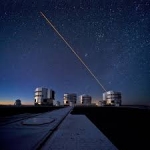Displaying items by tag: VLT (Very Large Telescope)
VLT (Very Large Telescope)
The Very Large Telescope (VLT) is a telescope operated by the European Southern Observatory on Cerro Paranal in the Atacama Desert of northern Chile.
The VLT consists of four individual telescopes, each with a primary mirror 8.2 m across, which are generally used separately but can be used together to achieve very high angular resolution. The four separate optical telescopes are known as Antu, Kueyen, Melipal and Yepun, which are all words for astronomical objects in the Mapuche language. The telescopes form an array which is complemented by four movable Auxiliary Telescopes (ATs) of 1.8 m aperture.
The VLT operates at visible and infrared wavelengths. Each individual telescope can detect objects roughly four billion times fainter than can be detected with the naked eye, and when all the telescopes are combined, the facility can achieve an angular resolution of about 0.001 arc-second. This is equivalent to roughly 100 metres (330 feet) resolution at the distance of the Moon. Unfortunately this means the VLT cannot be used to directly image the Apollo Moon landing sites as the largest objects left behind during each mission would only have been abou
MUSE (Multi Unit Spectroscopic Explorer)
The Multi Unit Spectroscopic Explorer (MUSE) is a second generation instrument installed at the Very Large Telescope (VLT) of the European Southern Observatory (ESO).
It is an integral-field spectrograph operating in the visible wavelength range. It combines a wide field of view with a fine spatial sampling and a large simultaneous spectral range. It is designed to take advantage of the improved spatial resolution provided by adaptive optics. MUSE had first light on the VLT on 31/01/2014.



